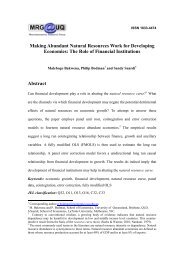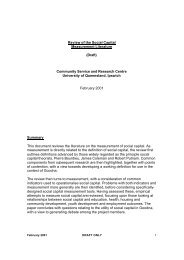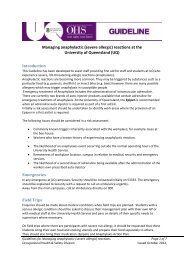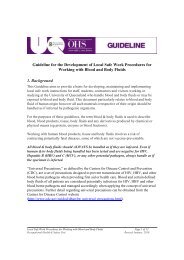Building a marketing strategy - University of Queensland
Building a marketing strategy - University of Queensland
Building a marketing strategy - University of Queensland
Create successful ePaper yourself
Turn your PDF publications into a flip-book with our unique Google optimized e-Paper software.
<strong>Building</strong> a <strong>marketing</strong><strong>strategy</strong>THE CENTRE FOR NATIVE FLORICULTURETHE UNIVERSITY OF QUEENSLAND
<strong>Building</strong> a <strong>marketing</strong> <strong>strategy</strong>Booklet no. 2 in the Value Chain Management series.Booklet 1: Market research for new floricultural productsBooklet 2: <strong>Building</strong> a <strong>marketing</strong> <strong>strategy</strong>Booklet 3: A practical guide to Value Chain Management in floricultureFor further details, contact:Dr. Lilly Lim-CamachoValue Chain ManagementCentre for Native FloricultureThe <strong>University</strong> <strong>of</strong> <strong>Queensland</strong>, Gattonlilly.lim@uq.edu.au07 5460 1647Assoc. Pr<strong>of</strong>. Tony DunneProgram Leader – Value Chain ManagementCentre for Native FloricultureThe <strong>University</strong> <strong>of</strong> <strong>Queensland</strong>, Gattonadunne@uqg.uq.edu.au07 5460 1332November, 2004.
In designing your product <strong>strategy</strong>, focus on your customer’s requirements. This should lead you toidentifying your product specifications. For example, a flower grower should consider thefollowing in designing a product <strong>strategy</strong>.! size ! colour! stem length ! amount <strong>of</strong> flowers! vase life ! sleeving! box sizes ! branding! how the flower agesThese are all issues that affect the quality <strong>of</strong> the product, how it will be used by customers, and howthey perceive it. There may be other issues associated with your product that you should add to thislist.In order to ensure that your customers’ requirements are met, you need to develop a system <strong>of</strong>checks. This involves making sure that the product’s quality is maintained throughout the process<strong>of</strong> delivering it to the final consumer. By doing so, your product arrives your customer in a formthat meets their specifications and expectations.It is important to understand that a product <strong>strategy</strong> not only involves the characteristics <strong>of</strong> theobject or service on <strong>of</strong>fer, but also how it is packaged and branded, and how its quality measures upagainst expectations <strong>of</strong> customers and consumers.Branding is more than just a sticker on a box, or a name on a piece <strong>of</strong> paper – your brand conveysthe quality <strong>of</strong> the product that you supply. If you choose to brand your product, you must rememberthat the product you supply will convey the image that your brand brings to your customers andconsumers minds.This lilly pilly label conveyscharacteristics <strong>of</strong> the plant: it’s anAustralian native, and it grows fastThe boxes above contain informationon flower colour, stem length, and thesource <strong>of</strong> the product.Similarly, the packaging <strong>of</strong> your product does not only provide protection or storage for yourproduct, but also is a means <strong>of</strong> promoting your brand. The information found on your packagingcould be a very valuable way <strong>of</strong> promoting your product.3
. Placement (distribution system)The next issue to tackle is how to get your product to your customer. Your placement <strong>strategy</strong>should address the issues <strong>of</strong> distribution – in other words, it deals with identifying the best route toget your product from your location to its end point – the retailer.In designing your placement <strong>strategy</strong>, think <strong>of</strong>:! what processes you need to get your product to the retailer, and! who can help you do that.Traditionally, the supply chain exported flowers has involved the use <strong>of</strong> exporters, importers andwholesalers. You should be able to identify who is involved in your chain, and what roles they playin modifying your product or facilitating its movement.Woolworths or Japan? Your placement <strong>strategy</strong> will varysignificantly depending on who your customer is.The important points to consider here are:1. Does my present distribution system allow me to access the best market for my product?2. Do I receive adequate feedback from my partner in the distribution system that allows me toassess my product’s competitive performance?Your placement <strong>strategy</strong> should identify the ideal supply chain for your product, and this dependson the segment <strong>of</strong> the market that you are targeting. A supplier <strong>of</strong> flowers to domestic supermarketswill have a very different supply chain to one supplying florists overseas.Booklet 3: A practical guide to value chain management in floriculture in this series will exploremore <strong>of</strong> how your placement <strong>strategy</strong> and distribution system can be utilised to create competitiveadvantage for you and your supply chain partners.Making sure that your product arrives the consumer in the best possible form is paramount, andlogistics is a main contributor to this. Logistics involves all transport, handling and storageactivities. As floriculture products are <strong>of</strong>ten perishable and very fragile, you need to maintain yourcool chain at all stages to keep your products in the best form.Because you are dealing with a fresh product, you have to ensure that it travels in the best possibleway. How your flowers are packaged, the temperatures at which they are stored, and the speed atwhich they travel contribute to the quality that your customer and the end consumer receive.4
Logistics should add value to your product – not reduceit, or leave you at a loss. It should come at a reasonablerate so that the value <strong>of</strong> your product can support yourlogistical costs.Get it there – QUICK! Becauseyou are dealing with freshproduce, logistics can make orbreak your product.Two aspects are important when planning your logistics<strong>strategy</strong>:1. That all logistical tasks are carried out efficientlyso as to minimise cost2. That these tasks are done pr<strong>of</strong>essionally so as topreserve the product’s quality.Your placement <strong>strategy</strong> ensures that efforts you put into your product <strong>strategy</strong> are worth the while.It ensures that the value you created reaches the consumer.An important aspect <strong>of</strong> your placement <strong>strategy</strong> is how effective your chain is. It is important thatyou understand your market in order to identify the most effective distribution system available.Work with people that you can communicate with, and who understand how your product should behandled and stored. The effectiveness <strong>of</strong> your chain will depend on how efficient its members are intheir roles.c. PromotionPromotion comes in many forms, but its aim is to help you communicate with your chosen market.You can do this by:! advertising through the media (get your product on a magazine?),! doing publicity stints (showcase your business at gardening and flower shows?),! conducting sales promotions (have a sale or better yet, give stuff for free?), or! simply talking to your customers (that’s personal selling).Point <strong>of</strong> sale advertising at nurseriesinform consumers and may persuadethem to purchase the product.Displays at OTA flower auction inJapan: Give freebies and you getpromotion for freeThrough promotion, you can introduce new products and ideas, inform your potential customersregarding your product, remind existing customers <strong>of</strong> your product, persuade them to try it, orstrengthen your image in your market.5
In planning your promotion <strong>strategy</strong>, it is best to consider which method would be the mosteffective in achieving your goals. What is it that you want your customers and/or consumers toknow? What is the best way to get to them?Promotional activities can be expensive, therefore you need to develop clear objectives for yourpromotional <strong>strategy</strong> and monitor its effectiveness.d. PricingYour pricing <strong>strategy</strong> will determine your viability in business. How you determine your price willdepend on:! your costs,! your position in the market (the image that you want customers and consumers to have), and! the level <strong>of</strong> competition in the market.For your pricing <strong>strategy</strong> to be effective, you must have a very good understanding <strong>of</strong> all three.There are various ways to market your productsoverseas. In Japan for example, flowers are <strong>of</strong>tenmarketed through the auction system. Auction marketsare a good way <strong>of</strong> making sure that your entireproduct is sold as there are many buyers. On the otherhand, there are also many sellers, and suppliers <strong>of</strong>product to auctions are <strong>of</strong>ten price takers – theyreceive what the buyer is willing to pay for on thatday, whether it represents the value <strong>of</strong> their product ornot.Other ways <strong>of</strong> selling your product are available.While auction systems dominate the Japanese flowermarket, some flowers are sold directly through wholesalers where you can negotiate a fixed price.However, you can only have the power to negotiate if you are able to meet what your customerwants. Fixed price sales <strong>of</strong>ten involve very high quality and reliable products.Because costs, positioning and competition vary in each market segment, your pricing <strong>strategy</strong>should also vary depending on how and where you market your product.As with your product, placement and promotional strategies, the success <strong>of</strong> your pricing <strong>strategy</strong>depends on how well you know your market – especially what it is they value.The price your end consumer pays for your product isthe maximum amount <strong>of</strong> money that can be distributedamong members <strong>of</strong> your supply chain. This pricereflects the value consumers perceive your product tohave, and therefore, are willing to pay for.The auction market is one way <strong>of</strong><strong>marketing</strong> flowers in Japan. There aremany buyers- but also many sellers.By understanding your customers and end consumersbetter, and improving your product according to theirneeds, you are able to maximise your product’s value,enabling you to command a better price, or increaseyour market share.The price <strong>of</strong> your product reflects itsvalue to those who purchase it.6
You are not the only firm in your chain who creates value for your end consumer. Select partners inyour chain whose <strong>marketing</strong> strategies are complementary to yours, and who are able to help youmaximise consumer value. In the end, your whole chain will benefit through increased market shareand better returns. High prices do not necessarily mean better returns – it is the efficiency andeffectiveness <strong>of</strong> the whole chain that dictates whether or not you and your partners will gain pr<strong>of</strong>it.Working together with chain partners is a more effective way <strong>of</strong> increasing consumer value, ratherthan working against them.Your <strong>marketing</strong> <strong>strategy</strong>: ImplementationA <strong>marketing</strong> <strong>strategy</strong>, no matter how well planned, is no good until it is implemented. Theimportance <strong>of</strong> implementation cannot be stressed enough as what distinguishes good managers andbusinesses from those that are average is their ability to execute a <strong>strategy</strong>.Implementing a <strong>marketing</strong> <strong>strategy</strong> involves:! identifying specific tasks to be completed! allocating responsibility for these tasks, and! completing the tasks in a timely and efficient manner.Each component <strong>of</strong> your <strong>marketing</strong> <strong>strategy</strong> – product, placement, promotion and pricing – willhave specific tasks associated with them. Identifying these tasks and managing the resources toimplement them requires attention to detail, cooperation and coordination. This is because most <strong>of</strong>these tasks cannot be achieved by you alone. Most <strong>of</strong> the time, you will have to work with yourcustomers and/or suppliers in order to implement them.As your <strong>marketing</strong> <strong>strategy</strong> is implemented, you will notice that changes will continue to occuraround you. New products might come in, more competitors might enter your market, customersmight slowly change their tastes. Your <strong>marketing</strong> <strong>strategy</strong> must adapt to these changes, andconstantly monitoring what happens around you is essential in keeping up to date. Your <strong>marketing</strong><strong>strategy</strong> defines how you compete in a chosen market segment. If this segment is constantlychanging, so should your <strong>marketing</strong> <strong>strategy</strong>.RememberThere are five points to remember from this booklet.1. Know your customer2. Get the product right3. Select your chain partners well4. Let your potential customers know about you, and5. Be prepared to change as your customers and consumers change.These points reflect your <strong>marketing</strong> <strong>strategy</strong>. Market research will help you identify what yourcustomers’ needs are. The continual monitoring <strong>of</strong> your <strong>marketing</strong> <strong>strategy</strong> will inform you abouthow well you are meeting your customers’ expectations. In addition its continued monitoring willidentify ways to adapt and improve your <strong>marketing</strong> <strong>strategy</strong>. It not easy, but it can be rewarding.7
Further readingDunne, T. (1999). Marketing agricultural products: An Australian perspective. South Melbourne,Oxford <strong>University</strong> Press.The Flower Export Council <strong>of</strong> Australia Inc, FECA (1998). A study <strong>of</strong> the USA flower market.Barton, RIRDC.The Flower Export Council <strong>of</strong> Australia Inc, FECA (1997). A study <strong>of</strong> the Japanese flower market.Barton, RIRDC.8
THE UNIVERSITYOF QUEENSLANDTHE CENTRE FOR NATIVE FLORICULTUREThe School <strong>of</strong> Agronomy and HorticultureThe School <strong>of</strong> Natural and Rural Systems ManagementThe <strong>University</strong> <strong>of</strong> <strong>Queensland</strong>, GattonThe Centre for Native Floriculture is located at the <strong>University</strong> <strong>of</strong> <strong>Queensland</strong> Gatton campus, which issituated approximately 80 km west <strong>of</strong> Brisbane, <strong>Queensland</strong>, Australia. It was established in May 2003 withan initial grant from the <strong>Queensland</strong> Department <strong>of</strong> State Development to assist in creating an internationallycompetitive native floriculture industry in <strong>Queensland</strong>.9


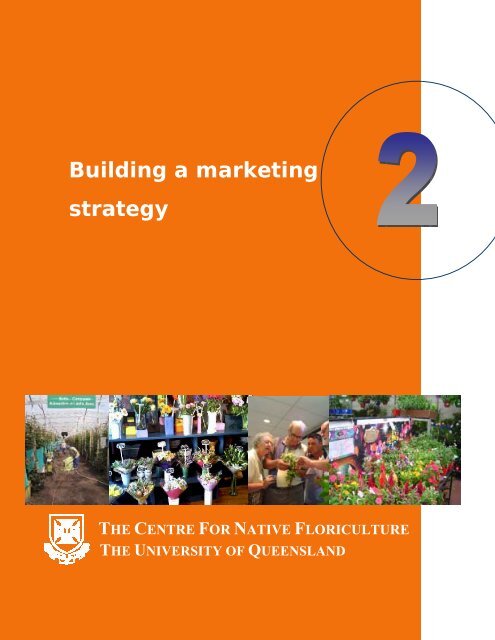


![Recycling [ PDF, 62KB ] - University of Queensland](https://img.yumpu.com/51805185/1/184x260/recycling-pdf-62kb-university-of-queensland.jpg?quality=85)



